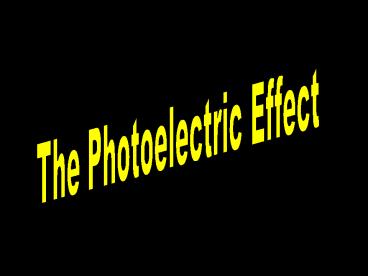The Photoelectric Effect - PowerPoint PPT Presentation
1 / 22
Title:
The Photoelectric Effect
Description:
Albert Einstein explained the photo- electric effect in 1905. He won the Nobel Prize for his work in 1921. ... The Photoelectric effect occurs when light is ... – PowerPoint PPT presentation
Number of Views:13491
Avg rating:5.0/5.0
Title: The Photoelectric Effect
1
The Photoelectric Effect
2
Is light a wave?
3
Or is it a particle?
4
The photoelectric effect is best explained by
treating light as a
Particle
5
I was only 26 in 1905!!
- Albert Einstein explained the photo- electric
effect in 1905. - He won the Nobel Prize for his work in 1921.
- He also published his special theory of
relativity in the same year.
1879-1955
6
The Photoelectric effect occurs when light is
shown on a metal. The light ejects electrons
from the metal producing an electric current..
7
METAL
8
According to classical physics, high intensity
light would eject electrons with greater kinetic
energy. Experimental results contradicted this
theory.
9
Experiments showed that the kinetic energy of the
electrons depended on the frequency of the light.
- Low frequency light, no matter how intense could
not eject a single electron. - High frequency light with a very small intensity
was able to eject electrons wit a large kinetic
energy
10
Experiments were done to find the relationship
between the kinetic energy of the ejected
electrons and the frequency of the incident
light. They resulted in the following graph
11
Slope h
Fo
max kinetic energy
frequency
y intercept ?
12
Written Relationship
- The kinetic energy of the ejected electron is
proportional to the frequency of the incident
light.
13
Slope h
Fo
max kinetic energy
frequency
y intercept ?
14
Mathematical Model
Kmax hf - ?
15
Light is a particle, called a photon. Each
particle has a energy that is directly
proportional to the frequency of the light.
E hf
E Energy h Plancks Constant (6.63x10-34
Js) f frequency of the light
16
? represents the work function of the metal. It
is the minimum energy needed to eject an electron
from the metal.
17
PRACTICAL APPLICATIONS
- The Photoelectric Cell
- video cameras
- electric eyes
- burglar alarms
- night lights
- solar power
- video games
18
(No Transcript)
19
(No Transcript)
20
Example The work function for a particular metal
is 3.2x10-19J. If the metal is illuminated with
light of wavelength 550nm. What is the maximum
speed of the emitted electrons?
21
- The maximum speed is
- 3.0x105m/s
22
Sample Quiz
- The photoelectric effect is best explained by
treating light as a ___________? - Who won the Nobel Prize for the explaining the
photoelectric effect? - List two practical applications of the photo
electric effect.































